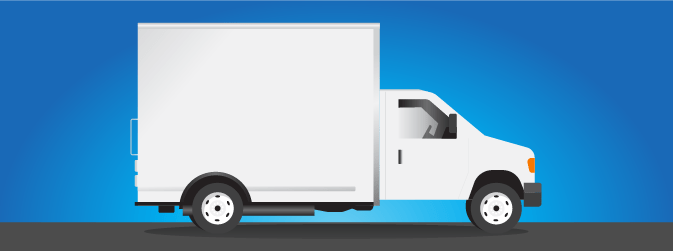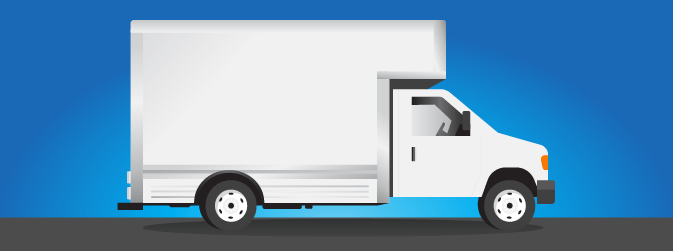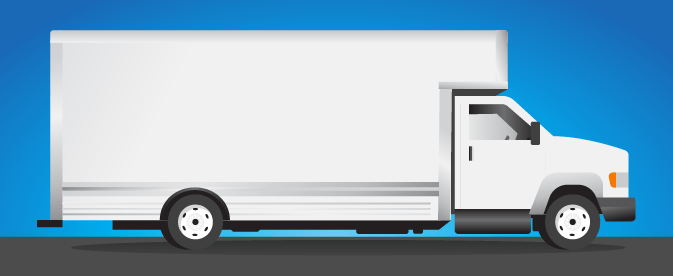How to Choose the Right Moving Truck Size
Are you planning a DIY move? Instead of storing everything in your mom’s attic, move all your stuff at once with a moving truck.
But how much truck do you need for your move? Depending on how much you’re moving, you might need more or less towing capacity, and that has a direct impact on how much you’ll spend on your move.
If you’re planning a move on a budget, every cent counts. You don’t have to do this on your own, either: moveBuddha is here to offer moving help every step of the way.
In this guide, we’ll show you how to pick the right truck size for your belongings — without the risk of running out of room or paying for unused space.
Why moving truck size matters
|
|
|
|
Sure, you could book a huge 26-foot truck for your one-way move, but do you really need that much space?
Before booking a moving truck, understand how much stuff you have and whether it will fit into the truck of your choosing. This matters because:
- Picking the right size moving truck will save you money: It’s just like in Goldilocks and the Three Bears. You don’t want a truck that’s too small. You don’t want a truck that’s too big. You want a truck that’s just right so you don’t bust your moving budget. By picking the right size, you’ll reduce empty weight while scoring the best rental rates for your move.
- It minimizes trips: Small loads are easier to carry into your new home, but that usually means you have to make more trips. Since many moving trucks charge gas mileage, it’s often a better deal to book an appropriately-sized truck for just a few trips, max.
- The right truck protects your belongings: If you’re transporting fragile items to your new home, you don’t want them bouncing around in the back of a cargo trailer. Picking the right-sized truck keeps your stuff packed tightly enough that it won’t jostle during transport.
Understanding moving truck sizes
Truck sizes differ by moving truck provider. All moving truck rental companies offer different sizes and types of trucks (Pro-tip: Enterprise has the best selection of different sizes, but they’re typically only available for in-town, round-trip moves).
Other rental companies like Penske, Budget Truck Rental, and U-Haul offer trucks in different sizes, although they tend to offer standard sizes. Keep in mind that these might vary by a few feet, but they’re generally similar.
When it’s time to plan your move, you can choose from pickup trucks, cargo vans, and small, medium, and large trucks.
Pickup trucks
If you just need to move some dressers and a few boxes, a pickup truck rental is an excellent option. This is ideal if you’re moving from dorm room to dorm room or if you need to move the contents of a small studio apartment.
The upside is that pickups are easier to drive and much cheaper than a full-sized truck. Pickups usually have a larger fuel tank size and get better miles per gallon (MPG), so you’ll save on the rental rates as well as gas mileage.
The only downside to a pickup truck rental is that it doesn’t have a low deck or EZ-load ramp, like a moving truck. You’ll need to lift everything up into the bed of the truck. If it rains, a truck exposes you to the elements, so check the weather before moving day.
- Typical size: Around 76 cubic feet
- Weight limit: Max load is 2,000 pounds
- Ideal for: Small, local moves for a one-bedroom home or apartment
- Price range: $130 – $300 total
Cargo vans
A more weather-proof option for small, local moves is a cargo van. Many moving truck rental companies offer cargo vans that give you a little more space than you’d get with a pickup truck.
The upside? You don’t have to try maneuvering a giant 10-foot truck around town
If you’re making a local move and don’t have too much stuff, this option might work for you. As a bonus, cargo vans are one of the most fuel-efficient moving truck options out there.
- Typical size: Around 250 cubic feet
- Weight limit: Max load is 3,700 pounds
- Ideal for: Small homes and local moves that require more space than a truck and protection from the elements
- Price range: $50 per day, but it depends on the provider. For example, U-Haul pricing starts at $19.95 a day, plus mileage and fees
Small moving trucks
If you have a larger studio or one-bedroom apartment, you might need a small truck instead of a pickup or cargo van.
Most moving truck rental companies offer small box trucks starting at ten or 12 feet. For example, U-Haul truck sizes start at ten feet and go as long as 26 feet.
89% of users select this mover
These trucks offer more space than a cargo van and give you better protection than a pickup truck. It’s much more secure if you need to store your stuff overnight in the truck before moving, too.
Small moving trucks are ideal if you’re moving a long distance. What’s great about these moving trucks is that you can pick them up and drop them off at U-Haul locations across the United States.
- Typical size: Around 400 cubic feet with a weight limit of around 3,500 pounds.
- Weight limit: Max load is 2,810 pounds
- Ideal for: Small long-distance moves
- Price range: $50 – $200
Medium moving trucks
If you’re moving belongings from a larger apartment or a small one- to two-bedroom home, a medium-sized moving truck might fit the bill.
Depending on your moving company, a medium truck will fall into the 14- or 17-foot range. For example, medium U-Haul moving trucks are 15 feet, while Penske trucks are 16 feet.
Medium moving trucks work well for either local and long-distance moves. They’re not enormous, which means they’re still relatively easy to drive, while still offering quite a bit of space for your belongings.
This versatility makes medium-sized moving trucks one of the most popular options offered by most truck rental companies.
- Typical size: Around 800 cubic feet
- Weight limit: Max load is 5,000 pounds
- Ideal for: Small households moving either locally or long-distance
- Price range: $130 – $3,000
Large moving trucks
This is the biggest moving truck you can rent for a DIY move. It’s perfect for a larger apartment or home with three or more bedrooms.
Large moving trucks are usually 20 to 26 feet long, which makes them the most spacious option. If you have a lot of belongings — and hate the thought of making multiple trips — a large moving truck will probably have enough capacity to do the job.
- Typical size: Around 1,500 cubic feet
- Weight limit: Max load is 10,000 pounds
- Ideal for: Long-distance or local moves for a lot of household goods
Price range: $150+
What if you need more space?
|
|
|
|
|
|
So, what if you’re planning your move and realize you need more space than what a 26-foot truck will provide?
If that’s the case, you probably need to look into a full-service moving company rather than alternative moving truck sizes. Any vehicle larger than a 26-foot truck will require a special license to drive. Plus, you probably can’t operate it safely without experience operating commercial vehicles.
The moving service will handle everything for you, from loading to transportation to unloading. Some moving companies even offer packing services to seriously streamline moving day.
Another option is a moving container company. Most moving container companies only offer 8-foot, 12-foot, and 16-foot containers. However, there are some options in the industry with larger capacity. For example, Moving Place provides 28-foot and 53-foot containers. You pack and load them yourself, saving money, but the professionals handle the driving so you can move a larger home without as much hassle.
How do you choose the right size for your move?
89% of users select this mover
Instead of guessing, do a little bit of math to find the perfectly-sized truck rental for your move. You can estimate the size of the truck by either calculating the number of bedrooms or estimating the number of cubic feet required to move your stuff.
By number of bedrooms
This is the simplest way to estimate your truck size. The moving truck company you choose will provide a guide for which truck size to use for a different number of rooms.
For example, U-haul truck rentals say its 20-foot truck is ideal for a two-bedroom apartment/home or three-bedroom apartment.
Keep in mind that these rules change by provider, but here are a few good rules of thumb to follow:
- Studio apartment: Pickup truck, cargo van, or small moving truck
- 1-2 bedrooms: 15-foot moving truck
- 2-3 bedrooms: 20-foot moving truck
- 4 or more bedrooms: 26-foot moving truck
Remember that not all bedrooms are the same size. ”Bedroom” is hardly a standard unit of measurement, after all.
This is a guesstimate, and the amount of furniture you own, as well as the size of your current bedrooms, could skew your calculations.
By cubic feet
A more accurate way to estimate moving truck size is by looking at the cubic feet of your belongings and comparing that to the total cubic feet available in your moving truck.
You can calculate volume in cubic feet by measuring length X width X height. This works best if you can get a rough estimate of the cubic feet of all your belongings (or, at least, your large items like beds, couches, and appliances).
If you don’t want to spend all day measuring your furniture, a good rule of thumb is to allow for 150 to 200 cubic feet of space for each fully furnished room in your home.
Again, though, remember that room sizes vary, and so does the amount of furniture in a “fully furnished” room, so this is just another estimate.
Use calculators
You’re free to calculate your moving truck sizes solo, but online calculators are a helpful tool for checking your math.
Check out the moveBuddha Moving Cost Calculator to not only estimate the cost of your move, but also come up with a more accurate size estimate for your moving truck.
Getting a more exact estimate for moving truck sizes
89% of users select this mover
The last thing you need is to undershoot your moving truck estimate. The above methods are helpful for calculating a rough estimate, but it’s best to be as accurate as possible.
These methods require a little more work upfront, but they can potentially save you the hassle of paying for additional moving trucks when it’s time to relocate.
Take inventory
First things first, take inventory of everything you plan to move and your home size.
Start with larger items like:
- Beds
- Appliances
- Bulky pieces of furniture
Once you have the big stuff out of the way, move on to smaller items and boxes.
With your inventory list in hand, visit your rental truck company and check out the different moving truck sizes available. Give them the list and they can help you more accurately assess which truck size you’ll really need.
Cluster your items together
Go into each room of your home and move large furniture items together into a cluster. Try to stack them as you would stack them in the moving truck.
This takes some elbow grease, but putting everything together helps you visualize how much space your belongings take up.
Measure the cluster in each room and add everything together. This will give you a good starting point, but remember to include an allowance for small items and boxes, too.
You’ll probably need a little more space than you think!
Start packing early
It’s tricky estimating how many boxes you’ll need for small items in your home.
The best way to estimate your total number of boxes is to pack as early as possible. Start with the non-essentials to give you an estimate of how many more boxes it will take to pack your stuff up.
Add up the cubic square footage of these boxes (plus your furniture and large items) to get a good starting point of how much space you’ll need in a moving truck.
Consider how far you’re moving
If you’re making a long-distance move, you’ll likely want to err on the side of caution and book a larger truck. You probably aren’t going to make a cross-country drive more than once, so everything needs to fit on the truck.
With a local move, on the other hand, you can get away with booking a smaller truck since you can make multiple trips if needed.
Consider fuel prices and the fuel efficiency of the type of moving truck you’re considering, too. Sometimes it’s cheaper to size up to a bigger truck and move everything in one trip than it is to pay for fuel for multiple trips.
When in doubt, go with the bigger size
If your estimates put you smack-dab in the middle of two different moving truck sizes, go with the bigger option.
After all, it’s nice to have a little extra space to work with on moving day. This way, you don’t have to cram your belongings into a truck that isn’t quite big enough.
The next step: Choosing a moving truck rental company
|
|
|
|
|
|
Now that you have a rough idea of moving truck sizes and which one you need, it’s time to start researching moving truck rental companies. This way, you can reserve the right-sized truck long before moving day and tick one more task off of your to-do list.
If you like the affordability and convenience of a truck but don’t want to try driving a giant truck yourself, moving containers (like U-Box or PODS) are a great moving truck alternative.
But if loading and unloading sounds like too much to deal with right now, opt for a full-service mover to manage everything for you.
You’ve got a lot of options for your move. Instantly compare price quotes from multiple moving companies — including truck rentals, container companies, and full-service movers — with moveBuddha. Check out our Moving Cost Calculator now to start budgeting for your next move.
Not what you were looking for?
Check out other categories that can help you find the information you need!


















